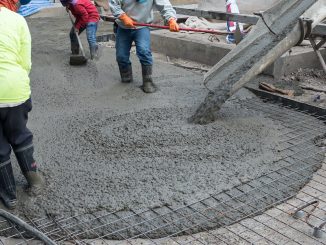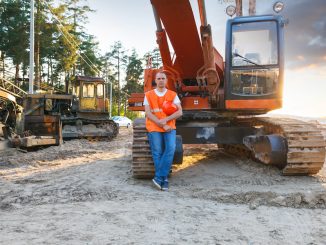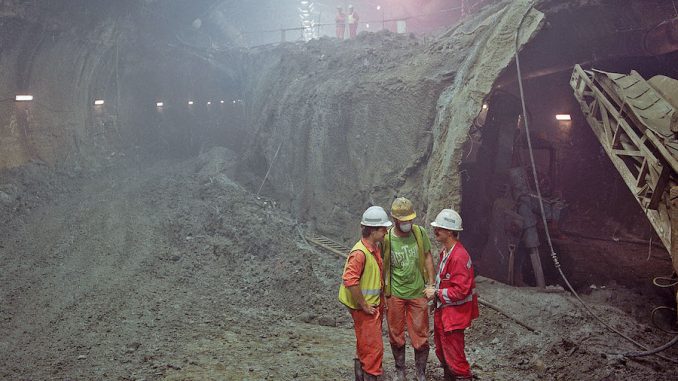
If you’re interested in engineering or construction, there are few projects more awe-inspiring than tunnels. By their very nature, tunnels defy the elements around them. Depending on where they are located, they may burrow through mountains, go under water, or protect passengers from the outside world.
Tunnels play a vital role in both ancient history and modern society. Throughout time, they have allowed passage in places that would otherwise be impassable. If you’re interested in tunnels, this list of twelve of the world’s best tunnels will get you started on an exploration of some true feats of engineering and construction.
Neelum Jhelum Hydroelectric Project (Pakistan)
As part of a massive hydroelectric project in the Kashmir region of Pakistan, the Neelum-Jhelum Hydroelectric Project boasts a whopping 42.3 miles of underground tunnels. These tunnels were constructed 1,247 feet below the Jhelum River, and through its bend. At the end of the tunnel, the water reaches a surge chamber, which contains a 1,19 foot tall surge shaft and a 2,690 foot long surge tunnel.
From the surge chamber, the water splits into 4 different penstocks, which each feed into a turbine generator in the underground power house. The water is then discharged back into the Jhelum River through a long-tail race tunnel. The drop in elevation between the power station and the dam generates an additional hydraulic head.
Started in the 1970’s, the project was became operational in 2017 after a Chinese consortium was awarded the contract to construct the dam and power station. Tunnel-boring machines were used to speed up the excavation of the tunnels, which first became operational in February 2013.
The tunnels of the Neelum Jhelum Hydroelectric Project are the sixth longest in operation in the world, and the largest in use for hydroelectric projects.
Length: 42.3 miles
Fast fact: In its trial run, the Neelum-Jhelum Project provided more than 1.3 million megawatts of power.
Yulhyeon Tunnel (South Korea)
The Yulhyeon Tunnel is the third longest railway tunnel in the world, yet that is not why it is notable. Instead, it makes the list as one of the greatest tunnels due to the sheer speed at which the tunnel of its length was constructed (three years and five months), making it truly a wonder of engineering and construction.
A single tube, double track tunnel, the Yulhyeon Tunnel connects Suseo to Station in Seoul and Pyeongtaek in Gyeonggi-do Province. It is part of the Korean Government’s “half-day life zone” plan for the country, which will allow for people to reach any point in the country in less than half a day.
Excavation of the tunnel, with a 107 square meter internal area, began in January 2012. Contractors primarily used drill and blast and New Austrian tunneling method excavation with immediate support methods. Excavation was completed in a total of 21 headings advanced from access points every 2 to 3 kilometers of the main tunnel length. In zones of soft ground, a pilot tunnel with a center pillar and double arch to full cross section was used to control ground deformations.
Length: 31.3 miles
Fast Fact: The tunnel makes up 82% of the Suseo High Speed Railway, which is currently under construction.
Vintage engraving of miners and tunnellers using compressed air engines, used in boring the Gotthard Tunnel, Switzerland. The Gotthard Tunnel is a 15.003 km long railway tunnel and forms the summit of the Gotthard Railway in Switzerland. It connects Goschenen with Airolo and was the first tunnel through the Gotthard massif. It is built as one double-track, standard gauge tunnel. Photo credit: The London Illustrated News, 1882.
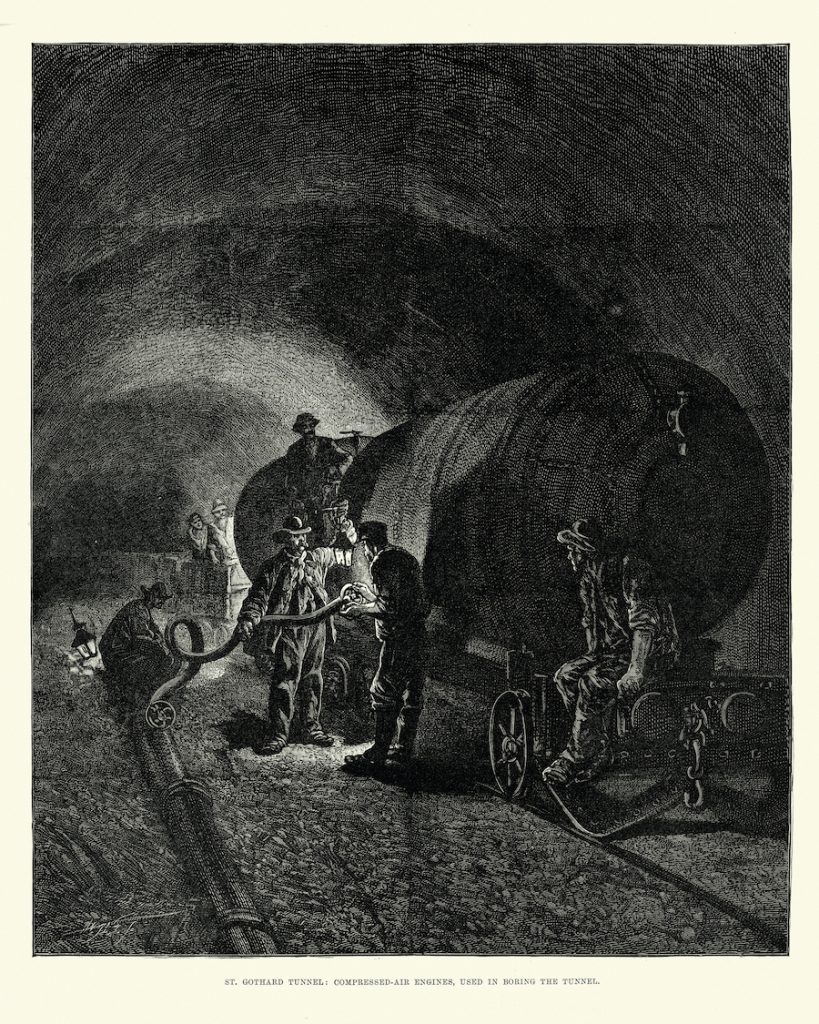
Gotthard Base Tunnel (Switzerland)
The Gotthard Base Tunnel holds the distinction of being both the longest and deepest tunnel in the world. Located inside of the Swiss Alps, it opened on July 1, 2016 after almost 20 years of construction. Full service began on December 11, 2016. The tunnel moves rail cars of both passengers and freight between Zurich, Switzerland and Milan, Italy.
The tunnel stretches for 35 miles and is approximately 7,5000 feet below the mountain peaks soaring above it. The Gotthard Base Tunnel serves an important role in the region by allowing a more direct route through the Alps rather than requiring individuals and companies to drive the winding routes through the mountains.
The project consists of two single-track tunnels. It is part of the New Railway Link through the Alps (NRLA) project. The main goal of the Gotthard Base Tunnel is to increase local transport capacity through the Alps, especially for freight. This will reduce the incidence of fatal road crashes and decrease environmental damage from freight trucks traveling over the Alps.
Length: 35 miles
Fast Fact: Passenger trains can travel up to 155 miles per hour through the tunnel.
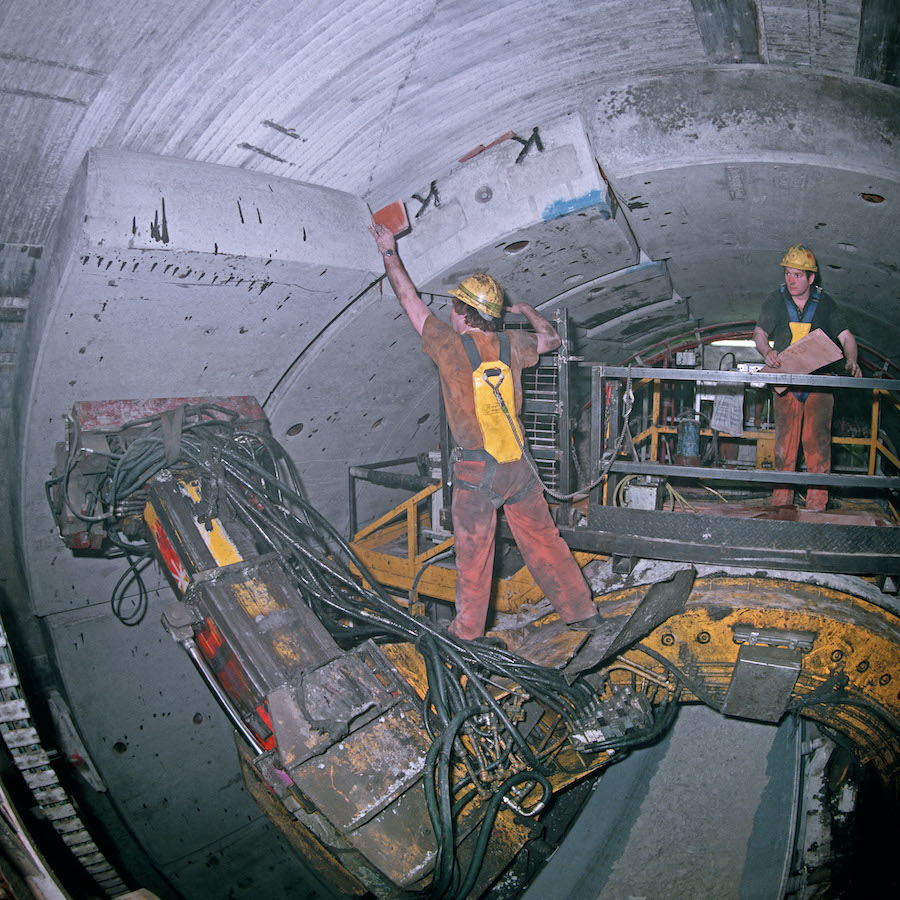
Channel Tunnel (England and France)
The Channel Tunnel (often referred to as the “Chunnel”) connects England with continental Europe. With entrances in Folkestone, Kent and Pas-de-Calais in France, the Channel Tunnel has the longest undersea section of any tunnel in the world at 23.5 miles.
The Channel Tunnel carries high speed Eurostar passenger trains, international freight trains and the Eurotunnel Shuttle for road vehicles. In 2017, the rail service carried 10.3 passengers, 1.22 million tons of freight, while the Shuttle carried 10.4 million passengers, 2.6 million cars, 51,000 coaches, and 1.6 million lorries (which is the equivalent of 21.3 million tons of freight).
The Channel Tunnel was bored through a chalk marl stratum that runs along the entire length of the English side. However, the French side of the tunnel has variable geology that made boring the tunnel more challenging. 11 separate tunnel-boring machines were used in the construction of the Channel Tunnel.
Length: 31 miles
Fast Fact: At its lowest point, the Channel Tunnel is 250 feet below the sea bed.
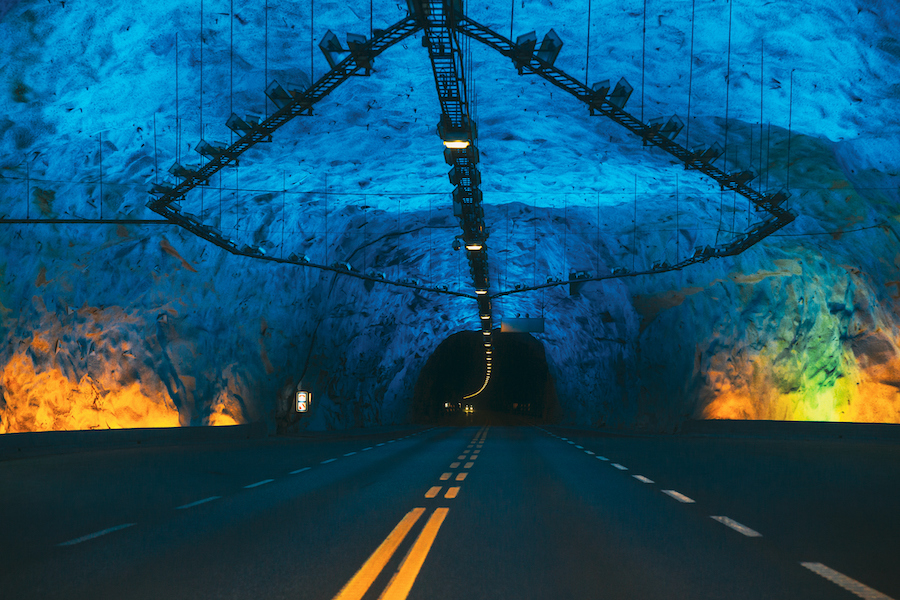
Laerdal Tunnel (Norway)
Opened in 2000, the Laerdal Tunnel is the world’s longest road tunnel. It serves to connect two cities in Norway, Oslo and Bergen, eliminating the need to drive through narrow mountain passes that are often blanketed in snow. One of its most important features is an extensive ventilation system that clears the tunnel of car exhaust, which would otherwise pollute the passageway.
Another key feature of the Laerdal Tunnel is how the engineers used lights to break up the monotony of the 20 minute long tunnel drive. The tunnel is equipped with white lights through the main portion. It then has three “caves,” which have blue and yellow lights that mimic sunrises. These areas offer a visual break and stimulus. They also offer drivers a place to run around as necessary.
The tunnel cost $153 million to build. To construct it, a total of 3.3 million cubic yards of rock were removed during construction from 1995 to 2000. The tunnel is divided into four sections at 3.7 mile intervals.
Length: 15.2 miles
Fast Fact: The tunnel does not have emergency exits, but it does have call boxes and other safety features, including wiring for the use of radio and mobile phones.
Tokyo Bay Aqua Line (Japan)
The Tokyo Bay Aqua line may be mistaken for a bridge, but it is actually a bridge-tunnel hybrid. Built to allow drivers to travel between Kawasaki and Kisarazu without having to drive the 60 miles around Tokyo Bay, the Aqua Line is innovative in several respects.
First, a bridge runs to Umihotaru Island — a manmade island constructed for purposes of this project. Second, the roadway then transitions into a tunnel that dips approximately 200 feet under the water to travel approximately 6 miles to the other side of the bay. The end result is that instead of a 90 minute journey around the bay, drivers can reach the other side in just 15 minutes.
One of the most interesting facets of the construction of this project is that the world’s largest undersea tunnel boring machines was used. This set the present for construction two-lane road tunnels. The tunnel was well-constructed to withstand seismic activity, as it showed no signs of significant damage during a 2011 earthquake.
Length: 8.7 miles
Fast Fact: Umihotaru Island also serves as a rest area and a mall.
Eisenhower Tunnel (United States)
Located in Colorado, the Eisenhower Tunnel has the distinction of being the highest vehicle tunnel in the world (according to Colorado). It sits at 11,158 feet above sea level. As it crosses the Continental Divide, the tunnel moves through the Arapaho National Forest. The twin bore tunnels stretches just under 1.7 miles, with each tunnel spaced between 115 and 230 feet apart.
The tunnels are 40 feet wide and 48 feet tall, with an exhaust and air supply system located above each tunnel. The tunnels rise toward the west and often rise sharply — at grades of up to 7%. The Eisenhower Tunnel opened in the 1970’s.
During construction, engineers and contractors ran into numerous issues, including the discovery of fault lines that were not found during pilot bores. In addition, the boring machines could not work as fast as anticipated at such high elevations.
Length:1.7 miles
Fast Fact: The Eisenhower Tunnel also serves as a water tunnel for water diversion from the western side of the Continental Divide to the eastern side.
Guoliang Tunnel (China)
The Guoliang Tunnel is both an impressive — and scary — tunnel road. Created in the 1970’s as a way to access the village of Guoliang in eastern China, the tunnel was carved out of rocky mountain cliffs of the Taihang Mountains. At just 15 feet high and 12 feet wide, it doesn’t leave much room for error. This is particularly true at the 15 separate openings along the way that expose the road to the cliffside.
The openings are frightening, but they served a purpose during construction; they allowed workers to discard excavated rock over the cliffs. Of course, when you are driving along the Guoliang Tunnel, it means that you are looking straight over the edge, down a potential drop of hundreds of feet.
The tunnel was constructed by hand between 1972 and 1977. Construction was achieved mainly through hammers and chisels, primarily by 13 villagers. One person died during construction.
Length: .74 miles
Fast Fact: A group of villagers sold their livestock to buy tools and materials so that they could create the tunnel.
SMART (Malaysia)
The Stormwater Management and Road Tunnel (SMART) system in Kuala Lumpur, Malaysia is an innovative project that does more than just cut travel time for drivers. It also alleviates pressure on the two major rivers in the city by moving flood waters away from where the rivers meet. In this way, SMART can stop water from entering critical parts of the city’s stormwater system. This prevents spillover in the city.
Opened in 2007, the double-deck roadway is the longest stormwater drainage tunnel in South East Asia. It is also the longest multi-purpose tunnel in the world. By 2010, the SMART system had prevented 7 potentially disastrous flash foods in the city.
It was constructed using tunnel boring machines at a cost of $514.6 million dollars. When there is flooding, it serves exclusively as a road tunnel. When there are floods, the upper level remains open, while rainwater is diverted to the lower level. If there is heavy flooding, then the tunnel closes to all traffic.
Length: 6.02 miles
Fast Fact: The roadway can only be used for light vehicles; motorcycles and heavy vehicles are not allowed.
Seikan Tunnel (Japan)
Opened in 1988, the Seikan Tunnel is the world’s second deepest and second longest rail tunnel. It was built to eliminate the often challenging crossing across Japan’s Tsugaru Strait, which is often beset by storms. The tunnel goes to a depth of nearly 800 feet below sea level, and connects the islands Honshu and Hokkaido.
Tunneling for this project occurred simultaneously from the northern and southern ends, with the dry land portions using traditional mountain tunneling techniques. For the undersea portion, three bores were used with increasing diameters: a pilot tunnel, a service tunnel, and finally, the main tunnel. Beneath the Tsugaru Strait, the use of a tunnel boring machine had to be abandoned because of the variable nature of the rock. Dynamite blasting and mechanical picking had to be used instead.
Length: 32.9 miles
Fast Fact: A tunnel to connect these islands had been considered since the early 1900s, but was not completed until the late 1980s.
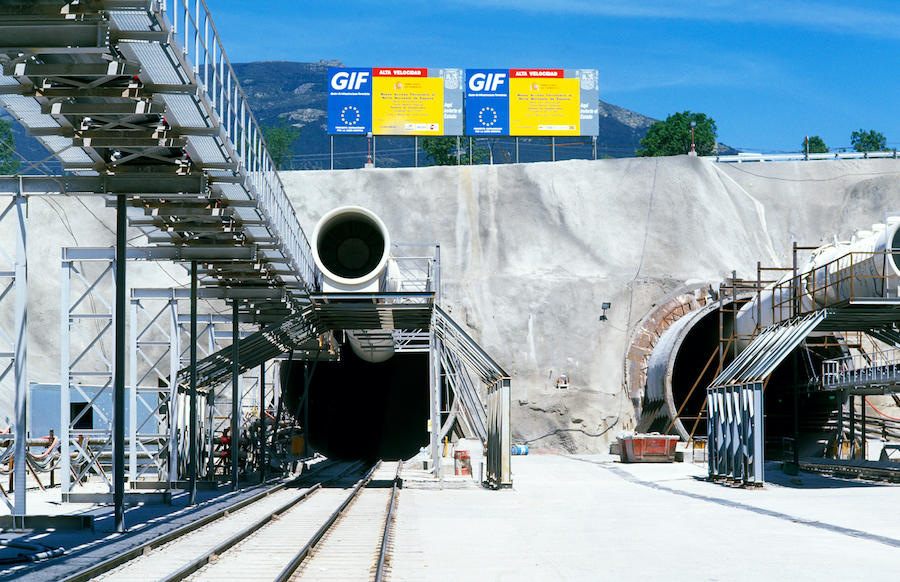
Guadarrama Tunnel (Spain)
Completed in 2007, the Guadarrama Tunnel is a railway tunnel across the Sierra de Guadarrama mountain range in Spain. It is part of the Madrid-Valladolid high-speed route running between Madrid and Segovia. Trains traveling on these tracks are capable of speeds of up to 310 km/hour (approximately 193 miles per hour).
Starting in Madrid, the Guadarrama Tunnel consists of two parallel tube tunnels. It is the longest railway tunnel in Spain, and the fifth longest railway tunnel in the world. It was first opened for service in December 2007.
The Guadarrama Tunnel was constructed using four double shielded tunnel boring machines, two Herrenknecht tunnel boring machines and two Wirth tunnel boring machines. One of each type of machine was used to excavate the north and south ends of the tunnel simultaneously. The tunnel took 5 years to complete.
Length: 17.65 miles
Fast Fact: The stone that was extracted during construction was transported to an old quarry, reducing the environmental impact of the project.
What is the world's longest and deepest tunnel?
The Gotthard Base Tunnel, located in Switzerland, holds the title for both the longest (35 miles) and deepest (approximately 7,500 feet below mountain peaks) tunnel globally.
Which tunnel project was completed in just three years and five months?
The Yulhyeon Tunnel in South Korea is notable for its construction speed, being the third longest railway tunnel in the world, completed in three years and five months.






































